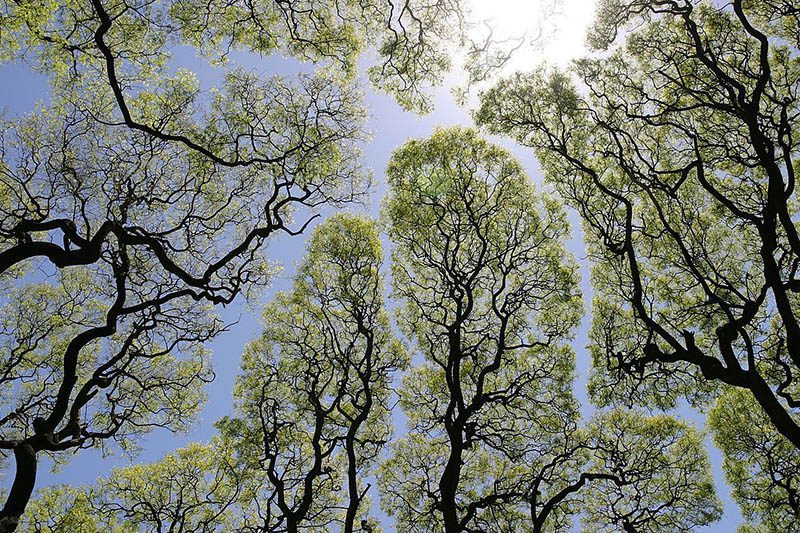Do you ever find yourself yearning for some solitude, a respite from the clamor of society? An opportunity to stretch your arms without making contact with another being? It’s a sentiment we all harbor from time to time, particularly in our current bustling world (although perhaps less so recently, given the isolation-inducing pandemic circumstances). Interestingly, we humans aren’t the only beings that value a little personal space. Some members of the arboreal world exhibit a similar tendency, favoring solitude over close-knit clusters. This peculiar pattern is known as “crown shyness,” a phenomenon where trees maintain a careful distance from one another’s crowns, creating an intricate tapestry of spaces in the woodland canopy that appears as deliberate as a crafted mosaic.
If you gaze up at a forest’s ceiling in certain parts of the world, you might see this remarkable spectacle unfold. The leaf-laden crowns of trees, instead of intermingling and overlapping as you might expect, part ways to avoid touching their neighbors. The result is a network of gaps that slice the sunlight into shifting, dappled patterns on the forest floor beneath. Though the phenomenon is most noticeable amongst trees of the same species, it is not exclusive to such instances and can, at times, emerge between trees of different species.
Crown shyness, despite its captivating aesthetic charm, is a phenomenon shrouded in mystery and scientific intrigue. Why do these arboreal giants maintain such precise boundaries? What prompts this apparent reverence for personal space? Read on as we delve into the fascinating world of “crown shyness,” exploring its potential causes, its ecological implications, and its breathtaking visual spectacle.
Exploring crown shyness
While crown shyness has been a subject of scientific curiosity and documentation since the 1920s, the exact reasoning behind this natural phenomenon remains cloaked in mystery. Referred to by various names, including “canopy disengagement” and “intercrown spacing,” crown shyness has elicited a number of theories, each attempting to decipher the biological rationale behind this captivating arboreal behavior. The diversity of these theories seems to suggest that the mechanisms driving this phenomenon could be different across various species.
One set of hypotheses postulates that the spaces appearing in the forest canopy are the result of mechanical damage to twigs and branches, resulting from forceful collisions during inclement weather. It suggests that as trees sway in high winds, their branches clash and break, eventually leading to a buffer zone of sorts, a no man’s land that exists to minimize future arboreal harm. Experimental evidence appears to back this theory: in controlled conditions where trees are prevented from wind-induced clashes, their branches tend to grow in a more contiguous fashion, gradually invading the vacant canopy space. Moreover, research findings indicate that trees do not exhibit crown shyness until they reach a certain size and their branches start colliding with neighboring crowns.
However, other researchers propose alternative theories that veer away from the mechanical damage hypothesis. Some suggest that trees maintain a safe distance from one another to stave off the spread of leaf-eating insect larvae. By avoiding physical contact with neighboring trees, they create a physical barrier that these insects cannot easily traverse, thus safeguarding themselves from infestation.
Yet another hypothesis centers on light sensitivity in the growing tips of the trees. It proposes that the terminal growth points of the branches are acutely sensitive to light intensity. As a result, they cease their expansion when they come into proximity with adjacent foliage, which leads to the characteristic gaps we associate with crown shyness.
Each of these theories offers fascinating insights into possible explanations behind this natural spectacle, though none can definitively claim to have solved the mystery. The quest to understand the complex web of arboreal behavior, particularly the enigmatic occurrence of crown shyness, is an ongoing journey in the world of scientific exploration.

An extraordinary natural phenomenon
In the final analysis, while the precise cause of crown shyness remains an elusive riddle within the realm of scientific discourse, one fact stands undisputed—the visual spectacle it offers is nothing short of extraordinary.
This mesmerizing phenomenon doesn’t require a journey to the remotest corners of the world to be appreciated. Rather, it graces us with its presence on a global scale, weaving its magic among a wide variety of tree species. From the aromatic Dryobalanops, also known as the camphor tree, native to the Malaysian rainforests, to the tenacious Pinus contorta or lodgepole pine, named for its propensity to twist and bend under stress, found in the cooler regions of North America.
Likewise, it can be observed in the tangled roots and arching branches of the black mangrove, a coastal dweller found in the tropics, to the towering eucalyptus of the Australian Outback with their distinct oil-scented leaves. Journeying further north, the Sitka spruce, a giant of the Pacific Northwest with its sharp, square-tipped needles, too, showcases this intriguing phenomenon in its dense, cone-laden branches.
Each of these species, in their unique habitats and distinct manners of growth, contributes to the broader tapestry of crown shyness. Despite their varied backgrounds, they all share this common thread, a visible testament to the tree’s unspoken negotiation for space, light, and survival.
So, next time you find yourself in the presence of these natural wonders, remember to gaze upward. You might just catch a glimpse of the delicate balance of nature, painted across the sky in the intricate puzzle pieces of the canopy, a testament to nature’s grand design and intricate orchestrations. The experience is sure to leave you spellbound, deepening your appreciation for the nuanced complexities of our natural world.


